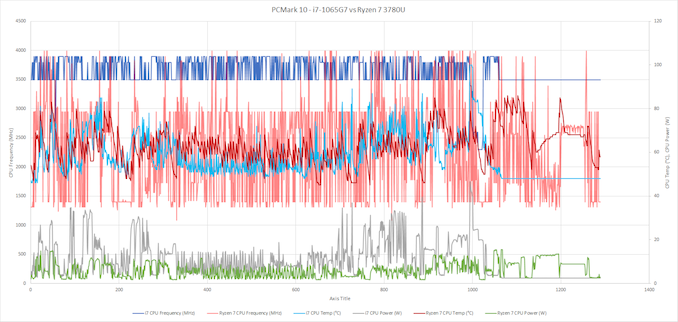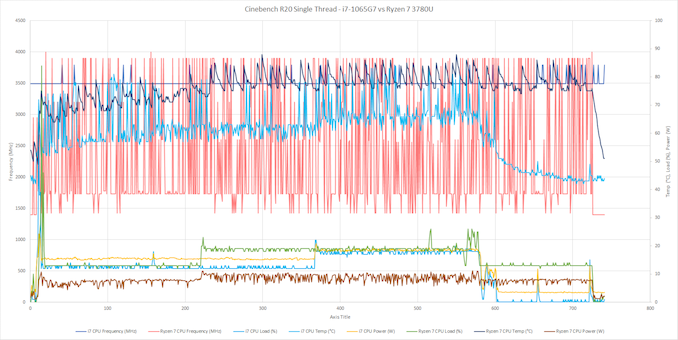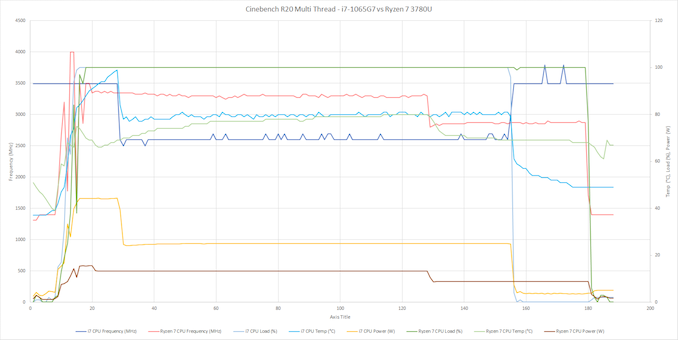The Microsoft Surface Laptop 3 Showdown: AMD's Ryzen Picasso vs. Intel's Ice Lake
by Brett Howse & Andrei Frumusanu on December 13, 2019 8:30 AM ESTBenchmark Analysis: Boost Behavior
Let’s dig into some of the testing to see how the systems responded during the benchmarks. We re-ran several of the tests while simultaneously monitoring the processor frequency, temperature, and power. Unfortunately for our comparison, the power polling results provided by our monitoring tools don’t seem to monitor the same power draw. The Intel power numbers are for the SoC package, but the AMD power numbers appear to be just the CPU cores, which is an unfortunate byproduct of testing two different platforms.
PCMark 10
PCMark 10 is a benchmark platform that attempts to simulate real-world tasks by running a variety of workflow, and the results were perhaps the most interesting of any of the benchmarks. There is a major discrepancy in how the AMD CPU behaved compared to the Intel. The Ice Lake platform kept the CPU frequency at a minimum of 3.5 GHz, with bursts to 3.9 GHz when under load. The Picasso processor was very aggressively switching from low frequency to high frequency, and was rarely indicating that it was over 3.0 GHz, but clearly demonstrating its higher peak frequency of 4.0 GHz in several locations. Both systems were fairly even in terms of CPU temperature, and Intel’s aggressive turbo levels were evident with peak power levels of 40 Watts for brief moments. The Ice Lake platform finished the benchmark about 200 seconds quicker than the Picasso system.
Cinebench R20 Single-Thread
We see somewhat similar results when only a single CPU core is loaded with the Picasso CPU frequency varying quite a bit. There’s also an average higher temperature on the AMD platform during this workload, and once again Ice Lake finishes the rendering quite a bit sooner thanks to its stronger CPU cores.
Cinebench R20 Multi-Thread
With all cores loaded the graph is considerably altered. Here the AMD processor is able to maintain a much higher frequency across its cores for much longer, while Intel's chip is only able to maintain 3.5 GHz for about 30 seconds before it runs out of headroom, dropping the cores down to around 2.6 GHz. But despite the lower frequency, the much higher IPC on Sunny Cove allows the Ice Lake platform to finish quite a bit sooner.













174 Comments
View All Comments
Zoolook - Saturday, December 21, 2019 - link
LP memory uses half size channels compared to regular DDR among other things, if you haven't designed your controller for it, it won't work, and since LP memory has only been used in the mobile sector earlier there was no reason for AMD to design the controller with that in mind.Extra transistors that could be used better elsewhere.
RSAUser - Friday, December 13, 2019 - link
Remember this is Zen gen 1, when they still had the RAM frequency scaling issue vs infinity fabric.sorten - Friday, December 13, 2019 - link
Whoa, nice surprise for a Friday morning! Thanks for the review.Results are about what I expected, and I guess this was the risk for AMD pushing out their previous gen APU for a high profile product. I hope they get the Zen 2 APUs into products soon.
coder543 - Friday, December 13, 2019 - link
Microsoft really should have waited until mobile Zen 2.sing_electric - Friday, December 13, 2019 - link
Honestly, I have no earthly clue why MS makes most of the choices it does with its hardware products. They launched the Surface Studio with a Maxwell GPU right after Pascal came out... then waited 2 years until after Turing was out to update the machine with the Pascal GPUs they should have had at launch. For a machine that is theoretically for "creators" (though, let's be honest, is probably mostly found on the desk of the boss of whoever is actually doing the creating).They did the same thing with the ARM-based Surface Pro X with a custom chip based on the already-year-old Qualcomm 8cx. Honestly, the bigger surprise is that the updated Surface Pro series actually uses current-gen Intel chips soon after they launched.
tipoo - Thursday, December 19, 2019 - link
Bet the Studio 3 comes out right before Ampere too. I agree, sometimes it seems like they're deliberately making themselves a bit less appealing not to piss off their partners.TheinsanegamerN - Friday, December 13, 2019 - link
And miss all the holiday sales?Here is the issue: AMD's mantra is "wait until X", but when "X" arrives, it is outclassed by the competition, or comes out after the major holiday season. The rest of the world doesnt run on AMD's schedule, and this only hurts AMD. If MS didnt want to use zen+, the consumer model would have simply gone with ice lake.
Zen 2 APUs should have come out when the rest of zen 2 did.
Meteor2 - Friday, December 13, 2019 - link
For sure, but they don't have the money to do the development concurrently. Something had to give.lmcd - Friday, December 13, 2019 - link
More like they don't have the money to hold CPU releases for GPU integrationChiplet arch should fix this and let AMD integrate within the same cycle -- this should, in theory, be the last cycle or second-to-last cycle where AMD ships a previous-generation "APU."
RSAUser - Friday, December 13, 2019 - link
Don't think it was the money for mobile Zen 2, more likely lack of available wafers from TSMC, rather supply Desktop as enthusiast and gamers will then market the product while cashing in profits from Epyc.